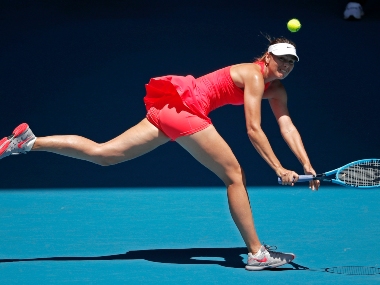See the ball, hit the ball – That’s been Maria Sharapova’s mantra through most of her career, and she stuck to it diligently in her Australian Open first round match against Donna Vekic. In fact, on some of her shots she didn’t even seem to be truly ‘seeing’ the ball; she was just taking blind, wild swings at it, in the hope that it would land as a winner. It’s a strategy that has worked for Sharapova in the past, and earned her five Grand Slams. But in 2020, against a player of Vekic’s quality, it was never going to be enough. Sharapova succumbed to a 6-3, 6-4 defeat to get her year off to the worst possible start, and it’s a mark of how far she has fallen that the loss wasn’t even that surprising. The Russian has now lost in the first round at the last three Majors, and is on a four-match losing streak overall. She has lost seven of her last eight matches on tour; the last time she strung together two wins in a row was exactly a year ago, at the 2019 Australian Open. Her loss on Tuesday is going to push her ranking to even more abysmal depths than it was already at – Sharapova is projected to fall from No. 145 to outside the top 350. [caption id=“attachment_7935851” align=“alignnone” width=“825”] Former World No 1 Maria Sharapova’s loss against Donna Vekic is the third loss in the opening round of the last three Majors the Russain has played in. AP[/caption] Injuries have admittedly played a role in that last bit, having reduced her playing time last year considerably. Even coming into the Australian Open, she was reportedly dealing with a right shoulder issue. But injuries have always been a big part of Sharapova’s career, and in the past they never seemed to affect her competitiveness when she was actually on the court. That’s not quite the case anymore. The question needs to be asked: Has the game passed Sharapova by? Since returning from her doping suspension Sharapova has looked like a pale shadow of her former self, with only brief sparks of brilliance dotting the largely barren run. Her serve has become chronically unreliable, her groundstrokes are not big or accurate enough anymore, and her foot-speed has gone down the drain. The worst part is that against Vekic, it didn’t just look like Sharapova was having a bad day; it looked like she was trying to power a new-age electric train with an ancient coal engine. Vekic started the match brightly, going up a double break in almost no time as Sharapova struggled to find the broad side of a barn with her groundstrokes. But the former World No. 1 hasn’t yet lost her will to fight, and when she blasted a few strong returns to get one of the breaks back, the crowd seemed relieved that they were at least going to see a competitive match. It certainly was competitive from that point on, but unfortunately for Sharapova she was always playing catch-up. Her late flourish in the first set was a little too late; even though she had started imposing herself in the rallies, all Vekic had to do to escape was hold serve once – which she did. The start of the second set was perhaps Sharapova’s only positive take-away from the match. Her serve acquired some venom and she started putting more spin on her forehand, which helped her race to a 4-1 lead. The stats showed that Sharapova was hitting her forehand around 4 kmph slower than the first set, and the added control she got from that was enough to give her the ascendancy over a somewhat subdued Vekic. But Vekic didn’t remain subdued for long. A couple of untimely errors and double faults from Sharapova gave the Croat a sniff, and when she got the break back she let out an ear-piercing scream. The loss of serve – or was it Vekic’s scream? – rattled Sharapova enough to make her go back to old habits. Abandoning her newfound emphasis on margin from the previous 20 minutes, she instinctively started going for broke again – with predictable results. Her inability to get enough second serve returns in play was particularly jarring; while she hit a few clean winners with that shot, she also missed more than her fair share of makeable ones. Moreover, Vekic was smart enough to recognize that trading blows with her legendary ball-striker wasn’t in her best interests. She stopped giving Sharapova the same kind of shot more than twice in a row, and that change of track was more than what the Russian could handle. By the time Vekic stepped up to serve for the match, Sharapova’s game was in free-fall. Even after she was gifted a double fault by a nervous Vekic on the first point, she failed to put the simplest of backhand putaways in the court on the next. Instead of 0-30 the score read 15-15, and Vekic duly finished it off from there. The loss, as it has frequently been with Sharapova of late, was largely down to the lack of nuance in the Russian’s game. She could comfortably match Vekic with her pace of shot from the ground, but had no answer when the Croat put the ball in even a slightly uncomfortable position. That is the Russian’s problem in a nutshell: she is still trying to hit the ball as hard as she possibly can, but in an era where the players are equally powerful but also quicker and more versatile. To be honest, Vekic herself doesn’t have the most creative or varied game; her biggest strength has always been her ability to muscle the ball out of her opponent’s reach. But even she had a lot of success by disrupting Sharapova’s rhythm with small changes in spin and trajectory, and that’s as severe an indictment of the Russian’s shortcomings as any. The woman is 32 years old now, and it is difficult to see where the resurgence is going to come from. They say you can’t teach an old dog new tricks, and that job is tougher still when the tricks have worked so well for so long. Sharapova is nothing if not stubborn, and ironically it was her stubbornness that made her such an iconic champion in the first place. But if she wants to continue playing the sport at the highest level, in an era where the likes of Bianca Andreescu and Ashleigh Barty have made variety fashionable again, that stubbornness has to give way. Maybe there is a need for Sharapova to work on her net game, or develop a slice, or even try becoming a topspin merchant. She has to do something; taking huge swipes at the ball come hell or high water is just not going to cut it anymore. The woman herself seems fully aware of the depth of the problem. “I don’t know, I don’t know,” she told reporters when asked whether she would play the Australian Open next year. “It’s tough for me to tell what’s going to happen in 12 months’ time.” It’s tough for the tennis world too, to see such a decorated champion endure such a monumental fall from grace. Sharapova’s fans have enjoyed watching her ‘see the ball, hit the ball’ mantra for more than a decade, but right now she’s not seeing the ball or hitting the ball well enough. It’s a sign that that mantra has run its course.
If Sharapova wants to continue playing the sport at the highest level, in an era where the likes of Bianca Andreescu and Ashleigh Barty have made variety fashionable again, that stubbornness – that made her the icon that she is today – has to give way.
Advertisement
End of Article


)

)
)
)
)
)
)
)
)



